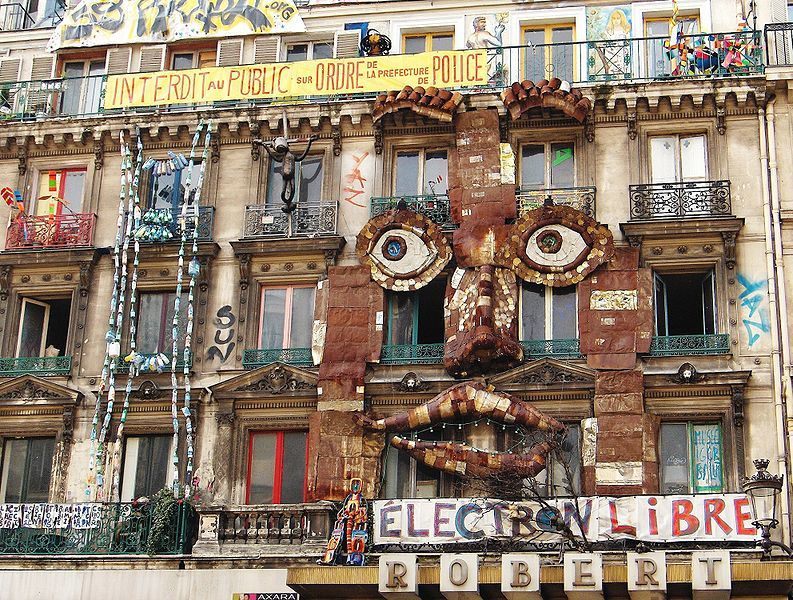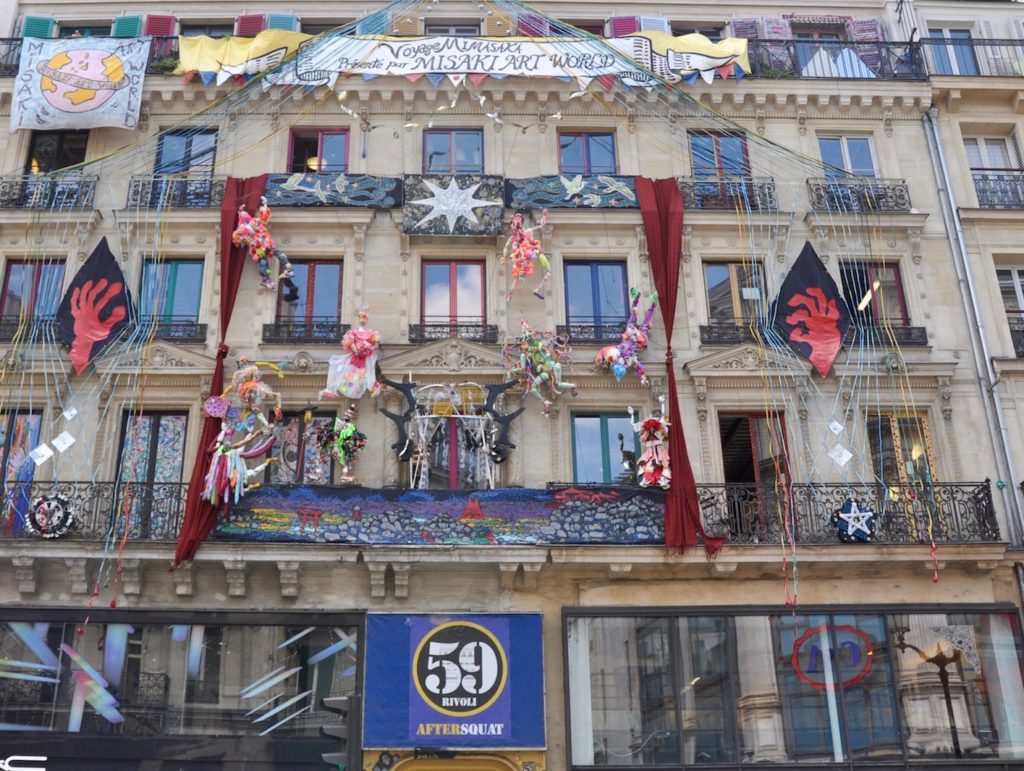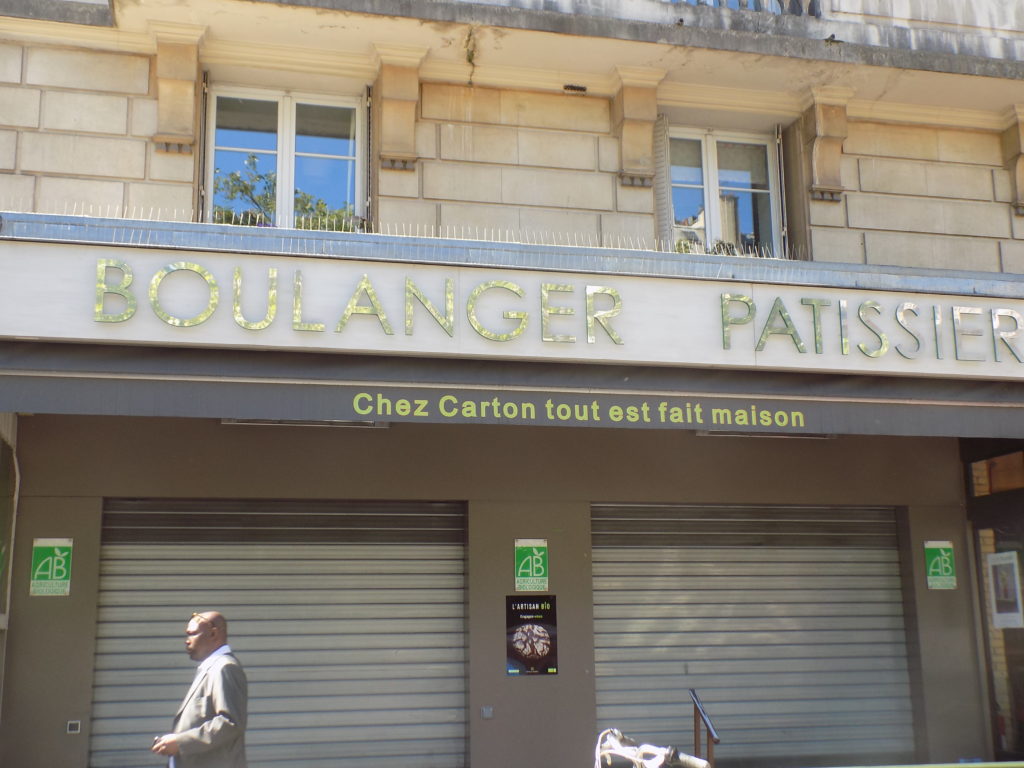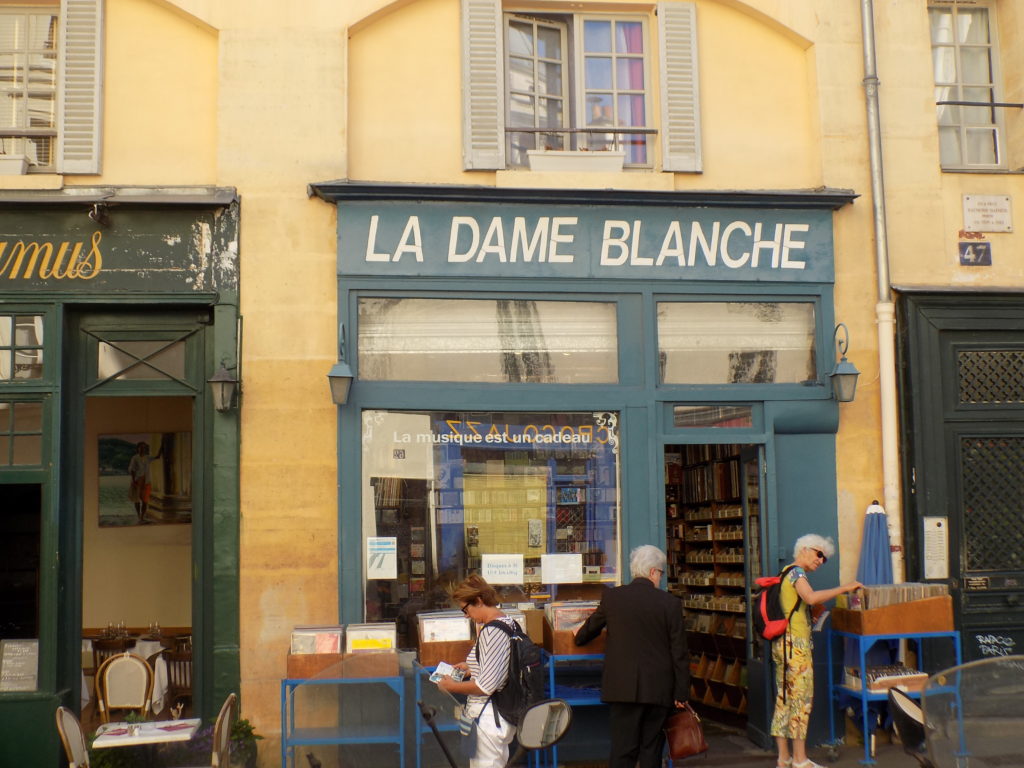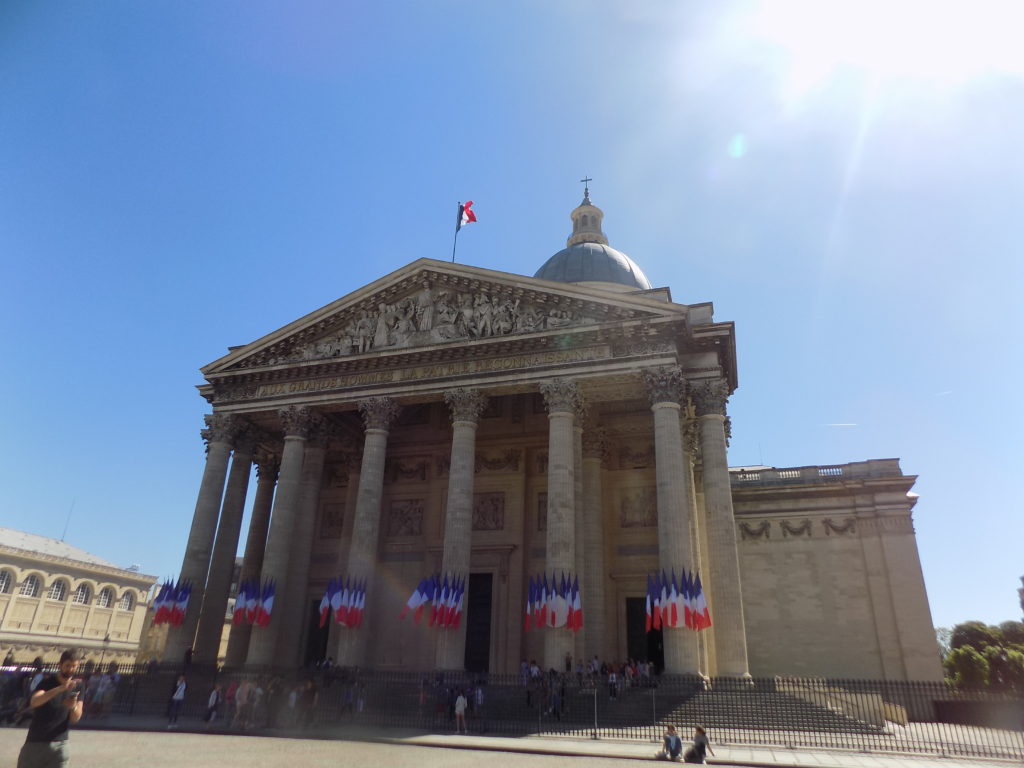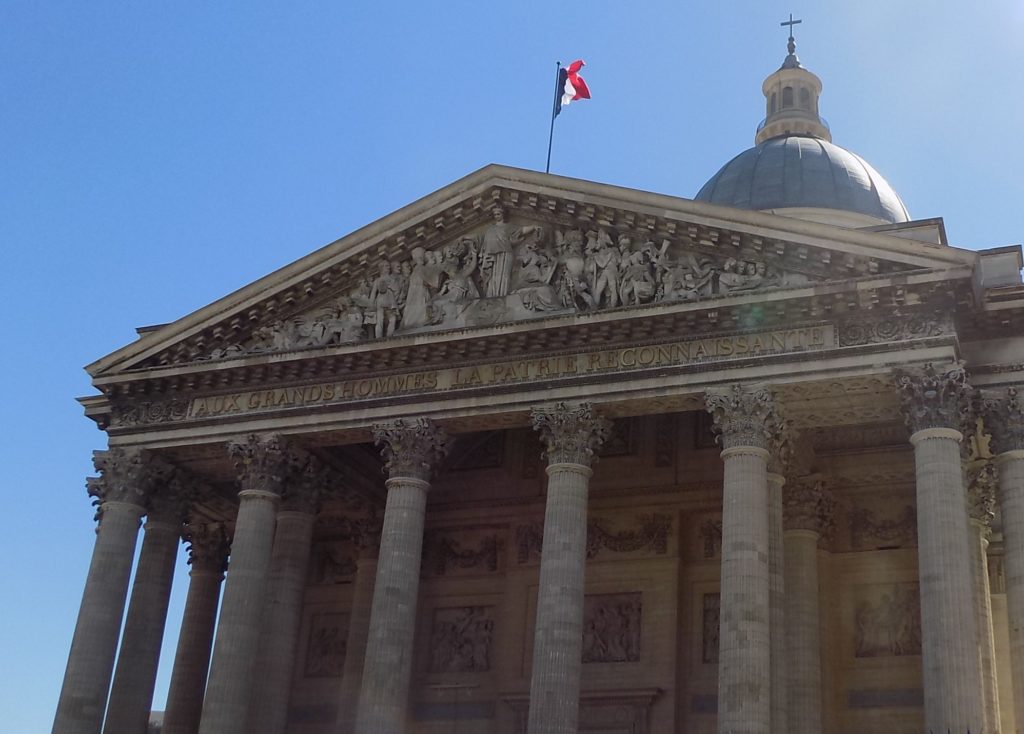The Americans who went up a mountain and called it a hill
Since neither of us were pilgrims nor, speaking for myself at least, particularly spiritually inclined, Patricia and I continued walking northwest from the Tour Saint-Jacques along rue de Rivoli and, I must admit, not entirely aimlessly. I wanted to reach the one-time bank building at 59 Rivoli that artists began using illegally for performances and exhibitions in 1999 after the bank abandoned it. It became so notorious and popular that the city of Paris acquired it and now it’s a legitimate low cost studio space and gallery. I wanted to see it because of this photo on Atlas Obscura
that I thought made it worth at least walking by. When we got there, it looked more like this.
And it was closed so we couldn’t visit any of the studios.
From this point, we wandered down to the Pont des Arts, crossed over to the Rive Gauche and found ourselves headed uphill in the general direction of the Panthéon which is, along with les Invalides, one of the two prominent domed buildings towering over the Left Bank. We might have found a map useful. For example, had we continued along rue de l’Odéon we would have stumbled our way to the Luxembourg Palace and Gardens but we were content to proceed without deliberate direction.
Some of you might remember the interesting encounter I had seeing my surname on a tomb in the graveyard of the church at Auvers-sur-Oise. Well, as we climbed up the hill in Saint-Germain, we came across what was for me a sadly shuttered but still notable boulangerie.
Everything might be homemade at Chez Carton but not by me or anyone related to me.
We also passed this shop (The White Lady) with a sentiment from that, for me at least, captured a significant part of our experience on this trip.
The message in the window reads “La musique est un cadeau.” Music is a gift.
We’d nearly crested the hill the Parisians call Montagne Sainte-Geneviève when we reached the church of Saint-Étienne-du-Mont. (I have to smile at the inclusion of ‘mountain’ in both the name of the hill and the name of the church. It is a hill but even then, not very much of one. According to Google maps, traversing the 850 meters from Shakespeare and Company to the Panthéon requires an ascent of a mere 17 meters. It’s so absurd calling this gradual ascent a mountain, I’ll even convert it for my metrically challenged friends. You climb about 55 feet over a distance of a bit more than half a mile.)
Even acknowledging their cultural importance, I generally have a limited interest in visiting churches and I am by the end of these trips even less inclined to visit them than I am at the beginning. Since Pat showed no particular interest in visiting Saint-Étienne-du-Mont either, we walked past it.
Here’s a little of what we would have learned had we entered. The first church near the site was in the Abbey Sainte-Geneviève and was built early in the sixth century. By the 13th century the population had outgrown the facility so in 1222 Pope Honorius III approved an autonomous church to serve the community.
The population eventually outgrew that church, too, and ground was broken on the current building in 1494. The Flamboyant Gothic choir was completed in 1537, the arc of the nave was raised in 1584, and Marguerite de Valois (the first wife of King Henri IV) laid the first stone of the facade in 1610.
Inside the church, we’d have found the shrine of Sainte-Geneviève – the patron saint of Paris – as well as the tombs of the 17th century playwright Jean Racine and, in what would have been a second repeat encounter, Blaise Pascal.
Panthéon – Panthéoff
The story of the Panthéon – just more than 100 meters from Saint-Étienne-du-Mont – begins when King Louis XV left Paris in June 1744 and traveled to Metz where he planned to lead his troops who were fighting in the War of Austrian Secession. In August, he fell so deeply ill he vowed that should he recover he would replace the ruined church of the Abbey of Sainte-Geneviève with an edifice worthy of the patron saint of Paris.
Divinely assisted or not, the king recovered and the foundations for the new structure were laid in 1758. Like so many of these projects, however, its completion required decades and by the time it was finished in 1790, the elder Louis was dead, his son Louis XVI had been ousted by the Revolution, and would be beheaded two years later.
As for the massive edifice, the design began under Jacques-Germain Soufflot and was completed by Jean-Baptiste Rondelet after Soufflot died in 1780. It’s an early example of Neoclassicism, with its portico supporting 24 Corinthian columns modeled after the second century Pantheon in Rome. The overall design is that of a Greek cross and at 110 meters long, long, 84 meters wide and 83 meters high it’s indisputably large – particularly for Paris. (For comparison, Sacré-Coeur is 85 meters long and 35 meters wide and Notre-Dame is 128 meters long but only 48 meters wide.) The dome, inspired by St. Paul’s Cathedral in London, features three superimposed shells.
The Revolutionary government, intent on not permitting it to serve its intended theological purpose, changed it into a mausoleum for Frenchmen who had done something great for France. This should clarify the reason a building called Panthéon (a temple dedicated to many gods)
would not merely look like a Christian church but would have its dome topped by a cross. In fact, at times since its completion it has been a church.
Its first religious incarnation came when it was consecrated under Napoléon Bonaparte in 1806. He marked the occasion with the addition of Antoine-Jean Gros’ painting The Apotheosis of Saint Genevieve on the interior dome.
Its life as a church lasted for about a quarter century until the July Revolution of 1830 when it reverted to being the secular Panthéon. But its metamorphoses weren’t quite done. Following the revolution of 1848, the Panthéon became the Temple to Humanity. Louis Napoléon had it remade as Saint Genevieve’s church in 1851 before it underwent its final transformation and was secularized again in 1885.
A notable scientific event happened here in 1851 when the physicist Léon Foucault set up his famous experiment in which he installed his specially designed pendulum in the dome of the Panthéon to prove the rotation of the earth. (The video below is for those who don’t know what a Foucault Pendulum is or how it works. If you do, you can skip it.)
If you look up from the square in front of the building, you’ll notice an inscription on the pediment.
It reads, “AUX GRANDS HOMMES LA PATRIE RECONNAISSANTE” which means, “To great men (from) a grateful fatherland.”
Among the famous graves found in the Panthéon mausoleum are those of Rousseau, Victor Hugo, Émile Zola, Jean Moulin, Louis Braille, and Soufflot, its architect. In 1907 the chemist Marcellin Berthelot was buried there with his wife Sophie.
It’s not uncommon for bodies to be exhumed and re-interred at the Panthéon. For example, Marie Curie was placed there in 1995. In 2002, the remains of Alexandre Dumas were transported with great pomp from the Cimetière de Villers-Cotterêts in Aisne to the Panthéon. (And of course, there was the case of Mirabeau whose remains went in the opposite direction.)
Once again, Pat and I opted not to go in but to continue enjoying our day in the sun. So we set off around the north side of the Panthéon and walked east along rue Clovis. Not long after we crossed rue Decartes we encountered another remnant of an old friend.
Thanks to our walk with David and Alison, I immediately recognized this as a Rive Gauche section of the wall built by Philippe-Auguste in the first decade and a half of the 13th century. Just beyond the wall, rue Clovis ends at the junction with rue du Cardinal Lemoine. According to a sign, if we turned right, we’d be walking in the direction of the Irish Cultural Center. Another attraction to the right was the apartment where James Joyce lived in Paris. We eschewed that choice and turned left. Based on what I saw when I looked at the street on Google Maps, we didn’t miss much. There’s a plaque marking the location but there appears to be nothing more.
Breathe easily, dear reader. Only a single post remains.
